30 Orange Flowering Trees (With Pictures): Identification Guide
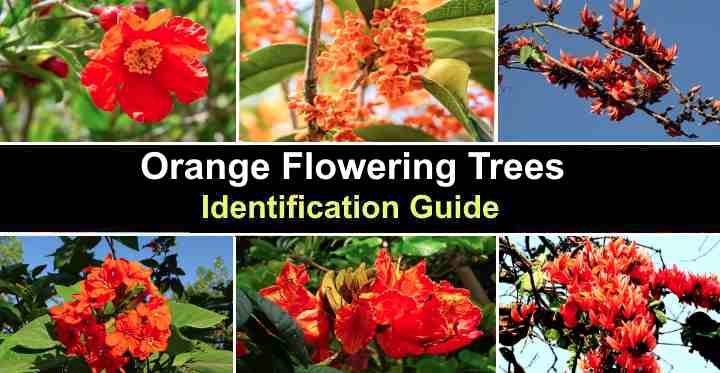
Orange-flowering trees are ideal for adding a splash of exotic colors to any garden landscape. Trees with orange flowers look stunning as their peach, apricot, amber, and pale coral colors contrast with lush green foliage. Orange-flowering trees can range in size from small ornamental varieties like the flame azalea or the scarlet wisteria tree to large shade trees like an elder tree or red silk cotton tree. The orange flowers enhance your yard’s aesthetics and add fragrance and texture to an outdoor space.
The best evergreen trees with orange flowers are tulip trees, magnolia trees, geiger trees, and flamboyant trees. Suppose you want to plant deciduous orange-flowering trees for their ornamental value. In that case, azalea, witch hazel, and pomegranate trees are excellent choices.
This article is an identification guide to the best orange flowering trees for front or backyards. Descriptions and pictures of different types of trees with orange blossoms will help you recognize and choose the best trees to add vibrant color to your landscape.
Orange Flowering Trees: Identification Guide With Pictures
Here are some of the best orange flowering trees to suit your landscaping needs.
Elder Tree (Tecoma Stans ‘Orange Jubilee’)

The elder tree cultivar ‘Orange Jubilee’ is known for its vibrant orange trumpet-shaped flowers. The orange funnel flowers are large and showy, and the blossoms are in full bloom for a remarkably long time. The fragrant orange flowers on the bushy shrub-like tree attract pollinators and hummingbirds.
The elder tree has glossy, dark green, lanceolate leaves with serrated margins. The evergreen orange-flowering tree is a fast-grower with a spreading habit. It’s suitable in larger landscapes as a shade tree. However, it grows well as a privacy screen, hedge, or foundation planting.
The ‘Orange Jubilee’ elder tree is drought-tolerant and thrives in hot, dry climates, where it’s exposed to sunshine throughout the day.
Mature Size: 10 to 20 ft. (2.4 – 3.6 m) tall and 8 to 12 ft. (2.4 – 3.6 m) wide
USDA Hardiness Zones: 9 to 11
Sun: Full sun
Orange Bells (Tecoma alata)
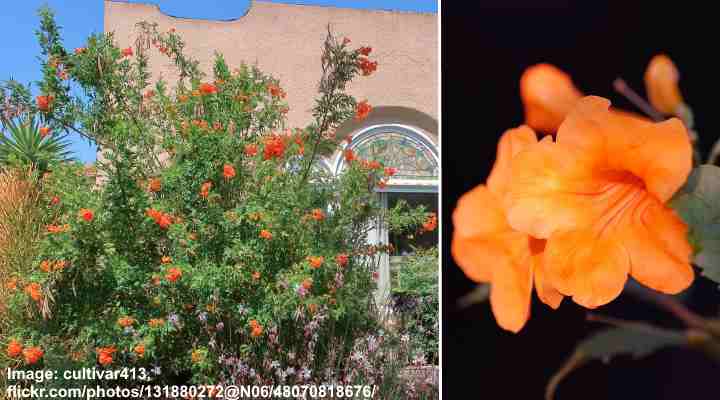
Orange bells is an orange-flowering shrub you can train to grow as a small tree. It’s prized for its vibrant tubular orange flowers in a trumpet shape. The evergreen plant blooms in late spring, and its orange flowers continue throughout the summer. The fragrant orange flowers, with their flaring petals, attract hummingbirds and butterflies, making the tree popular in wildlife gardens.
The orange bells tree has lush foliage consisting of glossy, dark green leaves with a slight fuzzy feel. The small tree’s orange and green colors make beautiful displays as a specimen plant, evergreen flowering hedge, or incorporated into a mixed border. It also performs well in large containers for patios or small gardens.
This small evergreen shrubby tree is adaptable to various soil types but prefers well-drained soil. It is a relatively low-maintenance plant that can tolerate drought, heat, and salt air. It’s suitable for semi-tropical coastal landscapes and arid conditions.
Mature Size: 8 to 12 ft. (2.4 – 3.6 m) tall and wide
USDA Hardiness Zones: 8 to 11
Sun: Full sun to partial shade
Jamaican Rain Tree (Brya ebenus)

The Jamaican rain tree is a small to medium-sized plant with small fragrant bright orange flowers. The eye-catching orange or deep yellow pea-shaped, bell-like flowers bloom in dangling clusters during summer. Other identifying features of the tree are its arching branches, green waxy obovate leaves, and bell-shaped yellow or orange flowers.
The Jamaican rain tree is a fast-growing tree that performs well as a shade tree thanks to its spreading canopy and dense foliage. In addition to its beautiful flowers, the tree produces small dark brown seeds in papery casings.
The Jamaican rain tree tolerates a wide range of well-draining soil types. The exotic flowering tree is ideal for planting in warm, tropical climates and coastal landscapes. It performs well as a privacy screen, windbreak, or sun-loving shade tree.
Mature Size: 20 to 30 ft. (6 – 9 m) tall and 15 to 20 ft. (4.5 – 6 m) wide
USDA Hardiness Zones: 10 to 12
Sun: Full sun to partial shade
African Tulip Tree (Spathodea campanulata)

The African tulip tree is a stunning dark orange-flowering tree native to tropical regions. The stunning tulip tree features large, upward-facing cup-shaped showy flowers that are bright orange or red on the outside and purple on the inside. The brightly colored flowers cover the tree’s irregular canopy when in bloom throughout summer.
The African tulip tree features large, glossy green leaves, providing a lush backdrop to the vibrant orange reddish flowers. The fast-growing tree performs best as an ornamental shade tree or specimen tree in frost-free areas like southern Florida or Texas. Its dense growth and attractive orange flowers create a stunning visual impact.
This tree prefers well-drained clay, loam, or sandy soil and full sun. It is also drought-tolerant once established. However, the African tulip tree is not cold-hardy and is best suited for growing in tropical or subtropical climates.
Mature Size: 50 to 60 ft. (15 – 18 m) tall and up to 50 ft. (15 m) wide
USDA Hardiness Zones: 11 and 12
Sun: Full sun or light shade
Red Silk Cotton Tree (Bombax ceiba)

The red silk cotton tree blooms in late spring and early summer with large, vibrant orange-red flowers. The tree’s bell-shaped flowers measure up to 5 inches (13 cm) in diameter. Identifying features of the red silk cotton tree are its orange flowers on bare, spiny branches before leathery palmate leaves appear. Its foliage, flowers, and showy 6” (15 cm) long seed pods create a lush, tropical look.
The red silk cotton tree is a deciduous, multi-stemmed tree that loses its leaves in the winter. After dropping its foliage, bright red or orange-red flowers appear, creating a stunning visual display in any tropical landscape.
Native to tropical regions and warm, humid climates, the red silk cotton tree is ideal as a decorative shade tree or specimen plant.
Mature Size: 60 to 75 ft. (18 – 23 m) tall and 40 to 60 ft. (12 – 18 m) wide
USDA Hardiness Zones: 10 to 12
Sun: At least six hours of direct sunlight daily
Pomegranate (Punica granatum)
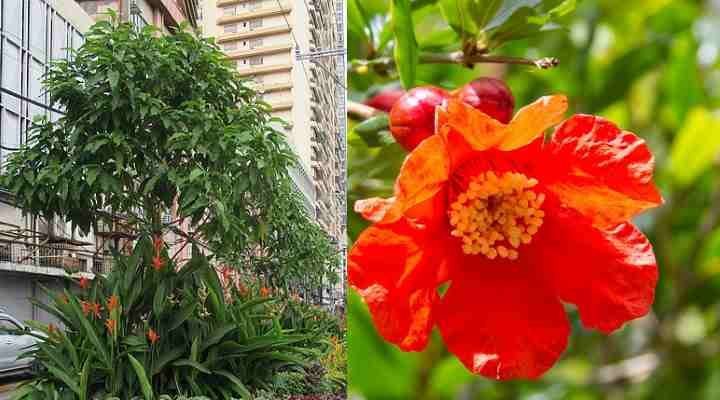
The pomegranate tree is known for its brilliant orange, red, pink, or yellow flowers. The vibrant, showy tubular flowers measure about 1” (2.5 cm) and feature crepe-paper-like petals in a funnel shape. Orange pomegranate tree flowers bloom for a long time, from late spring to early summer, creating a stunning display of color.
Pomegranate trees have glossy, dark green deciduous leaves that provide shade in the summer. The narrow, lance-shaped leaves turn a beautiful shade of yellow before dropping in the fall. The orange-flowering fruit tree is known for its large round reddish fruit about the size of an orange and filled with juicy sweet red arils.
Pomegranate trees thrive in most well-draining soils in warm climates. They are drought-tolerant trees and are ideal for growing in high temperatures. These versatile trees can grow as an accent plant, hedge, or specimen tree, and they perform well in containers on patios or deck areas.
Mature Size: 10 to 12 ft. (3 – 3.6 m) tall and wide
USDA Hardiness Zones: 8 to 10
Sun: Full sun or partial shade
Orange Champaca Tree (Magnolia champaca)

Also called the champak, the orange champaca tree is an orange-flowering magnolia tree. The tropical evergreen tree blooms with stunning orange cup-shaped, fragrant flowers. The highly aromatic yellowish-orange flowers have oval, wide-spreading petals forming a star shape. The orange champak tree blooms from mid-summer through early fall.
The orange champaca tree has glossy, dark green wedge-shaped leaves with a pointed tip. In addition to showy orange, cup-shaped flowers, the magnolia tree produces clusters of oval-shaped fruits containing orange or red seeds.
Native to Southeast Asia, the tropical tree is popular as an ornamental tree in warm climates. It is well-suited for gardens, parks, and other outdoor spaces to provide shade, colorful flowers, and lush foliage.
The orange champak tree prefers well-drained soil and full sun. It also requires regular watering throughout the summer season.
Mature Size: Typically up to 50 ft. (15 m) in cultivation
USDA Hardiness Zones: 10 to 12
Sun: Six to eight hours of direct sunlight daily
Flame of the Forest (Butea frondosa)

The flame of the forest is one of the most spectacular small ornamental trees with orange-reddish flowers. The eye-catching clusters of orange flowers and pointed petals bloom in rounded flowering heads resembling flames. The brilliant fiery orange flowers emit a sweet fragrance, attracting birds and butterflies.
The tree’s rounded, spreading canopy transforms into a mass of vibrant orange-red flowers when blooming from late winter through spring. Also, large dark green, leathery leaves provide shade in summer. Large flattened 4” (10 cm) seed pods appear on the tree in the fall, dangling from the crooked branches.
The flame of the forest tree has tremendous value as an ornamental plant thanks to its bright orange flowers and lush green foliage. You can plant it as a specimen tree or shade tree in sunny landscapes.
Mature Size: 30 to 40 ft. (9 – 12 m) tall and wide
USDA Hardiness Zones: 10 to 12
Sun: Full sun to partial shade
Scarlet Wisteria (Sesbania punicea)

The scarlet wisteria is an ornamental small tree or shrub with clusters of brilliant orange to red flowers. The showy orange flower clusters resemble the cascading blooms of wisteria plants, hence the name. The flowers bloom in late spring to early summer, attracting hummingbirds and butterflies.
Also called the rattlebox or Spanish gold, the scarlet wisteria has pinnately compound leaves with small green or grayish-green leaflets. The bushy multi-stemmed plant has a spreading, open-growth habit and can be trained as a small tree or allowed to grow as a shrub.
Scarlet wisterias are versatile, drought-tolerant plants that thrive in a variety of landscapes. You can plant them as ornamental shade trees in backyards and gardens. Its showy orange flowers create spectacular displays as an informal hedge or screen. The small trees also perform well in containers for use on a patio.
It’s important to note that all parts of the plant are toxic.
Mature Size: 10 to 15 ft. (3 – 4.5 m) tall and wide
USDA Hardiness Zones: 8 to 11
Sun: Full sun to light shade
Fragrant Orange Tea Olive (Osmanthus fragrans f. aurantiacus)

The fragrant orange tea olive is a small, hardy evergreen tree known for its highly fragrant tangerine-colored flowers. The tree’s tiny tubular orange flowers grow in showy clusters, giving off a sweet scent resembling apricots. The pale orange flowers contrast nicely with the lustrous dark green leaves.
The fragrant olive tree’s dark green, oval, pointed, leathery leaves create dense foliage, making it an ideal choice for year-long greenery. Landscaping uses for fragrant olive trees include evergreen hedges and privacy screens, foundation planting, or growing as a specimen plant. You can also plant them in containers to decorate patios or entryways.
Mature Size: 10 to 15 ft. (3 – 4.5 m) tall and 6 to 8 ft. (1.8 – 2.4) wide
USDA Hardiness Zones: 7 to 10
Sun: Full sun to partial shade
Royal Poinciana (Delonix regia)

The royal poinciana is one of the most spectacular orange-reddish flowering trees. Also known as the flamboyant tree, its umbrella-like spreading canopy is covered in dark orange blooms during late spring and early summer. The spectacular ornamental tree also goes by the name “flame tree” due to its fiery appearance.
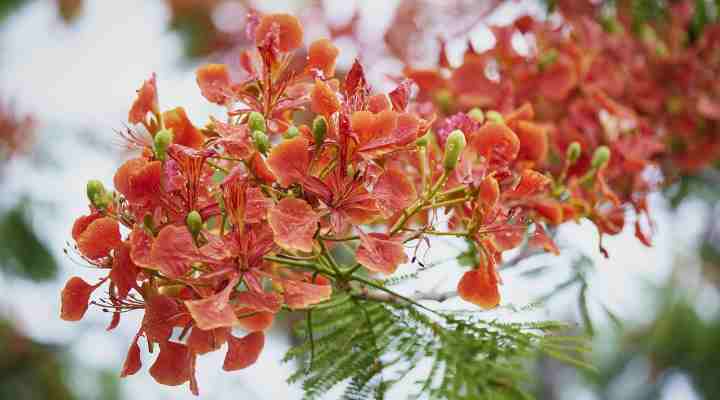
A close up picture of royal poinciana flowers
The royal poinciana has large, fern-like leaves that add to the tree’s exotic appearance. After the vibrant orange-red flowers have finished, long, brown bean-like 24” (60 cm), seed pods create a stunning visual display in the fall.
In warm climates like Florida and Texas, the ornamental flowering tree is evergreen. However, the feathery leaves drop in the fall in cooler climates, revealing the trees’ interesting branching structure.
The fast-growing royal poinciana prefers well-drained soil with medium moisture to thrive. It is a relatively low-maintenance tree but may require regular pruning to maintain its shape and size.
Mature Size: 30 to 40 ft. (9 – 12 m) tall and 40 to 70 ft. (12 – 21 m) wide
USDA Hardiness Zones: 10 to 12
Sun: Full sun
Mexican Bird of Paradise (Caesalpinia pulcherrima)

The Mexican bird of paradise is a striking orange-flowering tree with showy blossoms blooming throughout the season. The tree’s outstanding feature is its vibrant clusters of orange flowers, with curled and arching stamens. The stunning flowers, along with the ferny foliage, create colorful displays in sunny landscapes.
Mexican bird of paradise trees are drought-tolerant and thrive in hot, arid climates. Naturalized to Texas and the Sonoran Desert, the low-maintenance tree performs well as a screening plant, specimen tree, or to decorate a front-of-house foundation line.
The orange-flowering Mexican bird of paradise tree is a popular plant for desert gardens, xeriscapes, and tropical-themed landscapes.
Mature Size: 10 to 12 ft. (3 – 4.5 m) tall and wide
USDA Hardiness Zones: 8 to 11
Sun: Full sun
Flame Azalea (Rhododendron calendulaceum)
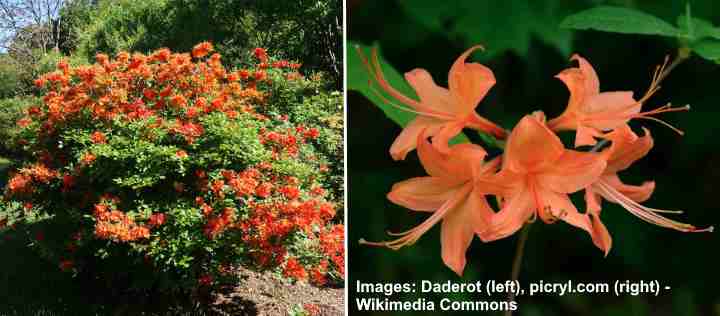
The flame azalea is a deciduous orange flowering shrub you can train to grow as a tree. Its showy orange flowers have eye-catching flowerheads consisting of fiery petals resembling candle flames. The glowing orange flowers bloom for two weeks in late spring and summer. When in full bloom, the stunning orange-red flowers cover the rounded canopy.
The foliage of the flame azalea comprises ovate to elliptic green leaves with a fuzzy texture. The deciduous foliage turns yellow and pale orange in the fall, creating a beautiful display of autumn colors. This compact tree is ideal for foundation planting, mixed borders, or privacy screens.
It prefers acidic, well-drained soil and partial shade. To extend its blooming time, deadheading the flowers ensures the decorative shrub or tree reblooms in late summer.
Mature Size: 4 to 8 ft. (1.2 – 2.4 m) tall and wide
USDA Hardiness Zones: 5 to 8
Sun: Partial shade or full sun
Orange Hibiscus Tree (Hibiscus rosa-Sinensis)

The orange hibiscus tree produces some of the showiest orange flowers on ornamental trees. The large, showy flowers have five papery petals and a prominent central stigma. They bloom throughout the year, adding a burst of color to any landscape. The orange hibiscus tree is a popular choice for tropical gardens. It can be planted as a focal point or in groups for a dramatic effect.
Here are some stunning examples of hibiscus trees with tropical orange flowers:
Hibiscus rosa-Sinensis ‘Apricot Brandy’: The tropical ornamental tree has double blooms with ruffled peach-orange petals creating peony-like flowers. It grows 8 to 10 ft. (2.4 – 3 m) tall and wide in USDA zones 9 and 10.
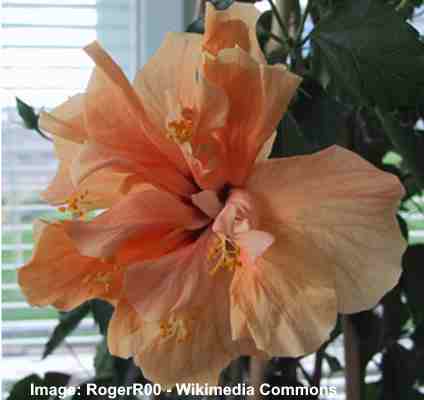
Hibiscus rosa-Sinensis ‘Apricot Brandy’
Hibiscus rosa-Sinensis ‘Cheri’: The decorative tree has large neon orange showy flowers with a rosy-pink throat. The small tree grows 7 ft. (2.1 m) tall in USDA zones 10 and 11.
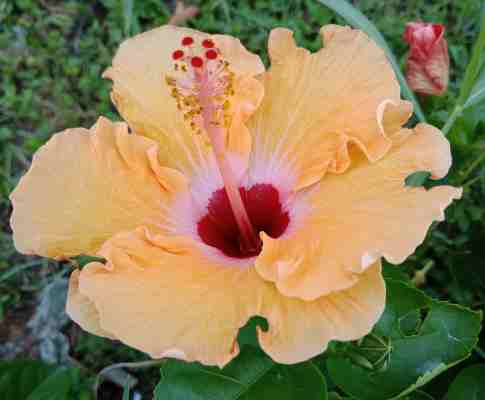
Hibiscus rosa-Sinensis ‘Cheri’
Hibiscus rosa-Sinensis ‘Electric Orange’: This tropical hibiscus hybrid has the brightest orange flowers on any hibiscus tree. The bright orange flowers contrast nicely with smooth, shiny green foliage. This ornamental tree grows 8 ft. (2.4 m) tall in USDA zones 9 through 11.
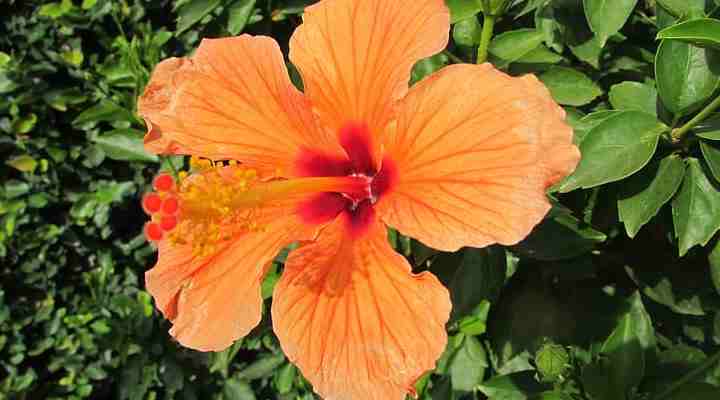
Hibiscus rosa-Sinensis ‘Electric Orange’
Hibiscus rosa-Sinensis ‘High Definition’: The showy double-petaled hibiscus flowers measure 6” (15 cm) in diameter. They have a bright orange color with yellow splotches and speckles. The small shrub or dwarf ornamental tree grows 5 ft. (1.5 m) tall in USDA zones 9 to 11.
Southern Silky Oak Tree (Grevillea robusta)
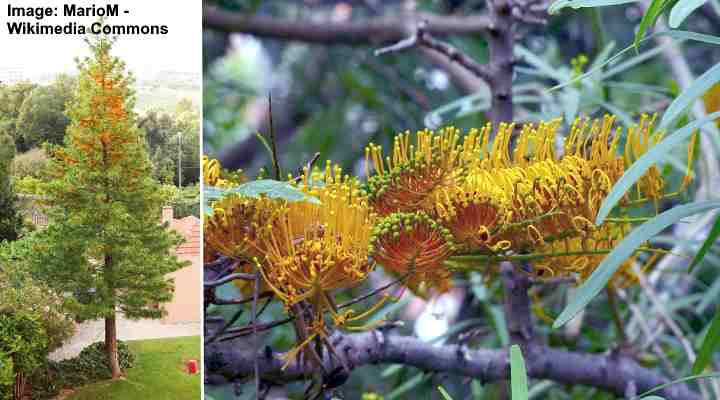
The southern silky oak tree is a large evergreen tree with stunning yellowish-red or yellowish-orange flowers. A characteristic feature of the orange blooms is their prominent, yellow-tipped orange stamens. These showy flowers create sprays of colorful clusters on the fast-growing tropical tree. The flowers stand out against the dark green, fern-like foliage.
In addition to its beautiful flowers, the southern silky oak tree has a tall and upright growth habit. The impressive tree is ideal in large landscapes where its dense canopy provides shade and a habitat for birds and other wildlife.
The southern silky oak tree prefers well-drained, sandy soil and full sun exposure. It is a drought-tolerant tree that thrives in the heat of Southern California, Texas, and Florida.
Mature Size: 40 to 70 ft. (18 – 21 m) tall
USDA Hardiness Zones: 9 to 11
Sun: Full sun
Angel’s Trumpet (Brugmansia)

The orange flowering angel’s trumpet is a sun-loving semi-tropical tree that can be identified by its trumpet-shaped pale orange to yellow flowers. When in bloom, the large tropical flowers hang down from the arching branches, creating a spectacular floral display. The sweet-smelling flowers have a strong fragrance and attract pollinating moths.
The easily identifiable feature of angel’s trumpet trees is their large funnel flowers that can reach up to 12” (30 cm) long. Together with the tree’s dense foliage and umbrella-like domed canopy, the angel’s trumpet tree makes a striking focal point in any garden.
This fast-growing tree blooms from spring through summer until fall. However, it has relatively high maintenance requirements. It requires regular pruning to maintain its shape. Also, it needs regular feeding during spring and summer to stimulate new flowers and growth.
Landscape uses for the angel’s trumpet tree include accent plant, specimen tree, and lawn tree. You can grow the decorative orange-flowering tree in containers to overwinter indoors in cooler climates.
It’s important to note that all parts of the angel’s trumpet tree—flowers, leaves, and bark—are highly toxic.
Mature Size: 6 to 35 ft. (1.8 – 10 m) tall and wide
USDA Hardiness Zones: 8 to 11
Sun: Partial shade
Geiger Tree (Cordia sebestena)
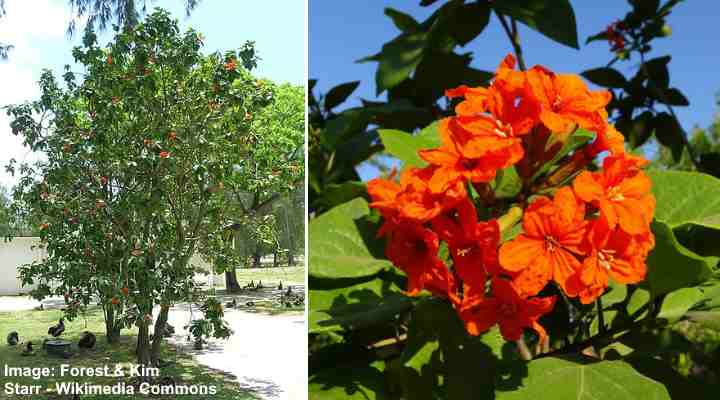
The orange-flowering Geiger tree is a small tree that can be identified by its vibrant orange flowers and heart-shaped leaves. The trumpet-shaped flowers cover the tree’s rounded canopy in bright orange colors when blooming throughout summer and fall. However, the small flowering tree can bloom year-round if the winter is mild. Other identifying features of the ornamental tree include its irregular branching habit, and white, egg-shaped fruits
The geiger tree is native to Florida and is common in tropical landscapes. Its compact growth and low height make it ideal for small gardens or to accent larger trees.
The geiger tree is also an ideal landscaping tree for coastal regions. It is tolerant of salt and brackish water, making it a useful ornamental tree in beach or seaside gardens. It’s low maintenance and can tolerate a variety of soil types, including sandy or clay soils.
Mature Size: 10 to 30 ft. (4.5 – 7.6 m) tall and up to 15 ft. (4.5 m) wide
USDA Hardiness Zones: 10 and 11
Sun: Full sun, light shade, or dappled sunlight
Ozark Witch Hazel (Hamamelis vernalis)

The Ozark witch hazel is a small, deciduous tree that produces clusters of fragrant dull orange or reddish-orange flowers in late winter and early spring. The decorative tree is known for its unique, spidery flowers that burst into color before the leaves emerge. The witch hazel flowers consist of four slender, strap-shaped petals with dark red centers.
The foliage of Ozark witch hazel trees emerges green with hints of bronze. In the fall, the dark green leaves turn golden yellow and usually persist on the tree through winter.
Landscape uses for this versatile shrub-like tree include a shrub border, specimen plant, flowering screen, or hedge. To encourage tree-like growth, it’s vital to remove suckers as they appear in spring.
Mature Size: 6 to 10 ft. (1.8 – 3 m) tall and 8 to 15 ft. (2.4 – 4.5 m) wide
USDA Hardiness Zones: 4 to 8
Sun: Full sun to partial shade
Flowering Maple ‘Victor Reiter’ (Abutilon ‘Victor Reiter’)
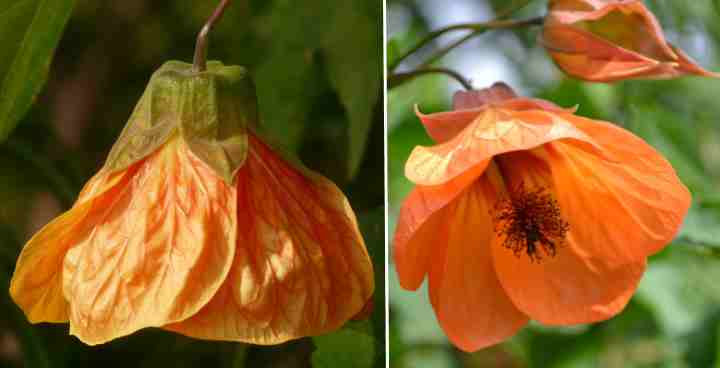
The flowering maple ‘Victor Reiter’ is a small tree known for its beautiful bell-shaped orange flowers. The outward-facing showy flowers are bright orange with greenish-yellow throats. They change gracefully from branches like dangling hibiscus flowers or colorful bells. The ‘Victor Reiter’ cultivar is prized for its prolific blooming and long-lasting flowers.
The sun-loving flowering maple tree has dark green, maple-like leaves. The lush foliage contrasts nicely with the attractive orange flowers that bloom from spring through fall. The pretty orange blossoms are perfect for adding a splash of color to small gardens, container gardens or to plant as a focal point in a landscape.
Flowering maples prefer well-drained, evenly moist, organically rich soil. With their continuous blooming and attractive foliage, flowering maples are popular for beautifying any garden.
Mature Size: 6 to 8 ft. (1.8 – 2.4 m) tall and 4 ft. (1.2 m) wide
USDA Hardiness Zones: 9 to 11
Sun: Full sun to partial shade
Japanese Flowering Quince (Chaenomeles Japonica)
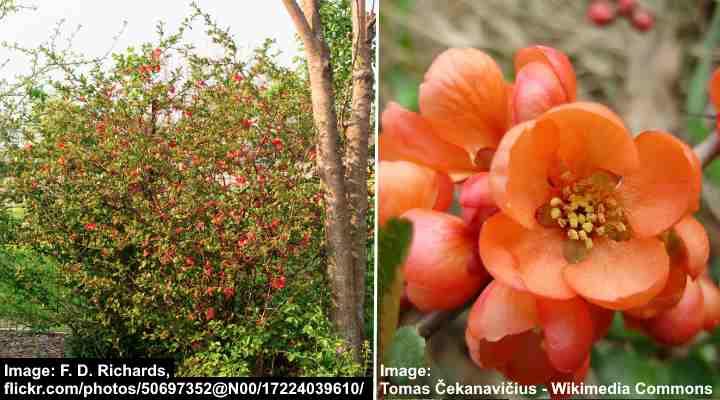
The Japanese flowering quince is a small deciduous shrub that produces beautiful orange-scarlet flowers. This compact shrub can grow as an ornamental dwarf tree. Its orange cup-shaped flowers appear in clusters in early spring before the leaves emerge on its thorny branches. These orange blossoms give way to small yellowish fruits with a tart taste.
This Japanese flowering quince is a versatile landscape plant. You can grow it as a low-flowering hedge, shrub border plant, or in a container. The shrub’s spiny branches with sharp thorns make it ideal for foundation plantings or a security screen around a backyard.
Mature Size: 2 to 3 ft. (0.6 – 1 m) tall and 3 to 6 ft. (1 – 1.8 m) wide
USDA Hardiness Zones: 5 to 9
Sun: Full sun to partial sun
Chilean Orange Ball Tree (Buddleja globosa)

The orange ball tree is a stunning bushy plant known for its globular clusters of bright orange tubular flowers. The fragrant orange flowers bloom throughout summer, attracting butterflies, bees, and other pollinators. Its bright yellow to orange spherical flowerheads provide a burst of color in any sunny garden.
Also called the orange flowering butterfly bush, its foliage is lance-shaped, with gray-green leaves. Additionally, with its rounded canopy, the tree has a compact growth habit, making it ideal for brightening tight spaces and small gardens. The dwarf tree is easy to prune to maintain its size and shape.
The Chilean orange ball tree is drought-tolerant and thrives in loamy soil with excellent drainage. It’s also resistant to deer, which is useful if you live in a rural community.
Mature Size: 10 to 15 ft. (3 – 4.5 m) tall and wide
USDA Hardiness Zones: 7 to 10
Sun: Full sun
Orange Bottlebrush Tree (Callistemon ‘Tangerine Dream’)

The orange bottlebrush tree is an orange-flowering shrub you can train to grow as a small ornamental tree. The ‘Tangerine Dream’ cultivar has striking bright orange flowers resembling bottle brushes. The unique flowers appear in spring and continue blooming sporadically throughout the year, attracting hummingbirds and butterflies.
The orange bottlebrush tree is popular for adding color to gardens and landscapes. Its shrubby growth makes it ideal for an informal hedge or evergreen screening plant. Additionally, the bushy shrub performs well in containers to brighten a patio or deck.
Mature Size: 5 to 6.5 ft. (1.5 – 2 m) tall and 3 to 5 ft. (1 – 1.5 m) wide
USDA Hardiness Zones: 10 to 12
Sun: Full sun
Coast Coral Tree (Erythrina caffra)

The coast coral tree is a stunning medium to large tree with eye-catching orange flowers. The tree’s common name comes from its clusters of vibrant tubular orange flowers that resemble deep orange or warm red coral. Each individual flower has a large petal surrounded by four smaller ones.
The orange flowers bloom in late winter and continue through late spring. These delightful orange-scarlet blossoms attract various pollinators, including birds and butterflies. Decorative features of the coast coral tree also come from its large, glossy, dark green, smooth, pale brown trunk and rounded, spreading canopy.
All species of coral trees are considered the official tree of Los Angeles, California.
It’s good to note that the tree has a thorny trunk. Therefore, it may not be suitable for planting close to play areas or walkways.
Mature Size: 30 to 40 ft. (9 – 12 m) tall and 23 to 36 ft. (7 – 11 m) wide
USDA Hardiness Zones: 9 to 11
Sun: Full sun
Australian Christmas Tree (Nuytsia floribunda)
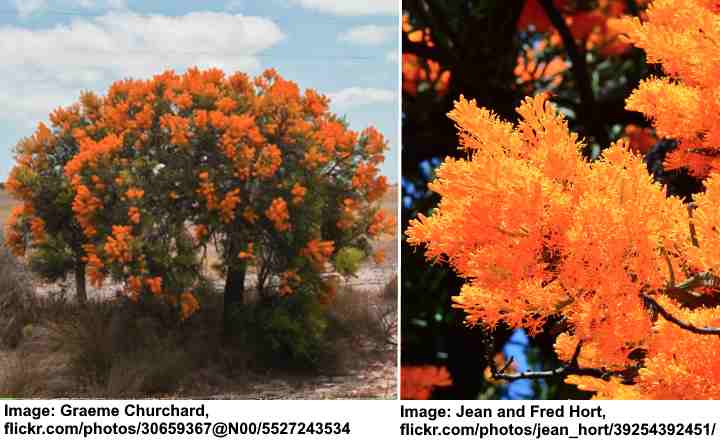
The Australian Christmas tree is known in the Southern Hemisphere for its breathtaking displays of vivid orange blooms in December. The tree’s striking orange flowers are small tubular blooms clustered on spongy branches. Additionally, the summer-flowering tree has small, gray-green to bluish-green and yellowish papery seed cases.
The Australian Christmas tree is a hardy tree that tolerates a variety of soil types, including sandy, gravelly, and drought-prone soils. This orange-flowering tree is popular in gardens and landscapes due to its unique and eye-catching flowers and compact growth.
Mature Size: Up to 33 ft. (10 m) tall
USDA Hardiness Zones: 9 to 11
Sun: Full sun to partial shade
Ashoka Tree (Saraca asoca)

The ashoka tree is a small to medium-sized tree prized for its beautiful clusters of rich orange flowers and eye-catching foliage. The large bunches of flowers are bright yellow-orange that turn deep red as the season progresses. The flowers are four-petaled star-shaped with long wiry stamens.
In addition to its beautiful flowers, the ashoka tree also has attractive evergreen foliage. The leaves are dark green and have a glossy texture, adding to the tree’s overall appeal. Its leathery green leaves grow in dense clusters.
The ashoka tree is relatively low maintenance and can tolerate various soil types. It prefers well-drained soil and is drought-tolerant once established. Typical landscaping uses for the ashoka tree are in garden borders, as an ornamental tree, and in butterfly gardens.
Mature Size: Up to 30 ft. (9 m) tall and wide
USDA Hardiness Zones: 10 to 12
Sun: Full sun
Scarlet Sterculia (Sterculia colorata)

The scarlet sterculia is a tropical tree known for its vibrant orange-reddish flowers. The tree produces large clusters of flowers that hang from branches. The scarlet flowers have a striking appearance and look impressive in any landscape. However, despite their visual appeal, scarlet sterculia flowers have one issue—they emit a foul stench.
The sterculia tree has a spectacular appearance when the colorful flowers bloom in early spring. The large orange flowerheads measure 1.2” (3 cm), with tubular flowers measuring 0.5” (1.3 cm) long. Around 30 orange tube-like flowers make up the flowerhead.
Scarlet sterculia trees have several uses in a tropical landscape. First, the trees have a wide-spreading canopy, making them ideal shade trees. Thanks to their dense foliage, the orange flowering trees also work well in urban gardens or as informal screens or hedges.
Mature Size: 30 to 50 ft. (9 – 15 m) tall and 20 to 30 ft. (6 – 9 m) wide
USDA Hardiness Zones: 6 to 9
Sun: Full sun to partial shade
Scarlet Gum Tree (Eucalyptus phoenicea)

The scarlet gum tree is known for its vibrant bright orange flowers that bloom in umbrella-like clusters. The orange flowers are striking due to the ray-like clusters of yellow-tipped orange stamens. These contrast nicely with the tree’s attractive silver-gray bark and narrow, lance-shaped gray-green leaves.
This scarlet gum tree is native to Australia and is well-suited to hot, dry climates. Apart from its long, pointed leaves and clusters of attractive orange flowers, the tree features stunning peeling orange-brown or pinkish-gray bark and a large, spreading crown.
Scarlet gum trees are fast-growing and are useful as shade trees or as a windbreak in open areas. The tree’s dense foliage provides privacy and creates a peaceful atmosphere in the garden. Its aromatic foliage, showy flowers, and interesting bark give the tree a four-seasonal visual appeal.
Mature Size: 13 to 40 ft. (4 – 12 m) tall with a widely spreading canopy
USDA Hardiness Zones: 8 to 10
Sun: Full sun
Cudjoe Wood Tree (Bonellia macrocarpa)

The cudjoe wood tree is a unique orange-flowering tree with unusual star-shaped orange blossoms. Introduced to Florida, the small heat-tolerant, sun-loving tree with its nectar-rich flowers has a spreading canopy of dense, evergreen foliage. Its lance-shaped leaves measure 1.5” to 2.8” (4 – 7 cm) long.
The cudjoe wood tree is drought-tolerant and can withstand salty conditions, making it ideal for coastal gardens. It prefers well-drained soil and full sun but can also tolerate partial shade. The tree blooms in the spring and early summer, attracting pollinators like bees and butterflies.
Mature Size: 6 to 15 ft. (1.8 – 4.5 m) tall
USDA Hardiness Zones: 10 and 11
Sun: Full sun
Orange Frangipani Tree (Apricot Plumeria)

The apricot frangipani tree is a tropical tree famous for its vibrant, colorful flowers, including stunning tropical apricot-orange and pink blooms. Frangipani trees produce clusters of fragrant, waxy flowers with five overlapping petals forming a star shape. The highly fragrant orange and pink flowers stand out against the tree’s glossy, dark green leaves.
The frangipani tree is a popular choice for tropical gardens, as it adds a splash of color to tropical garden landscapes as a shade tree. The tropical trees, with their waxy leaves and striking orange flowers, form a focal point or specimen tree. You can also grow orange frangipani trees in containers in colder climates and overwinter them indoors.
Mature Size: Up to 26 ft. (8 m) tall and 13 ft. (4 m) wide
USDA Hardiness Zones: 10 to 12
Sun: Full sun
Discover more than 200 flowering trees.
Related articles:
